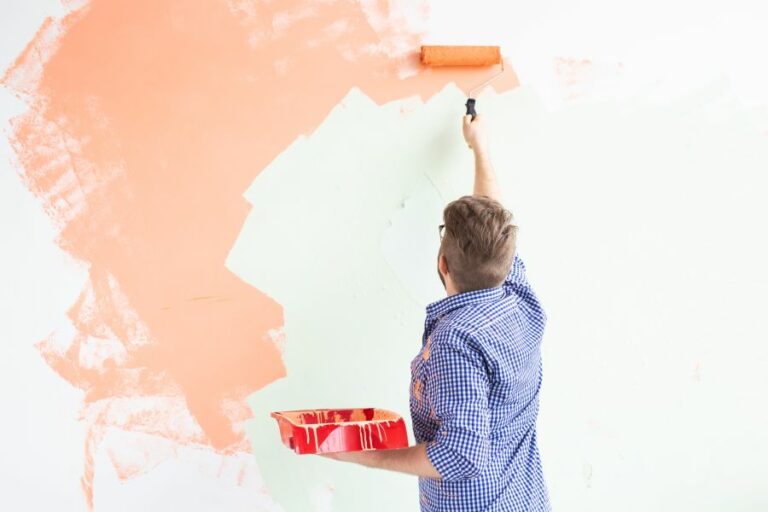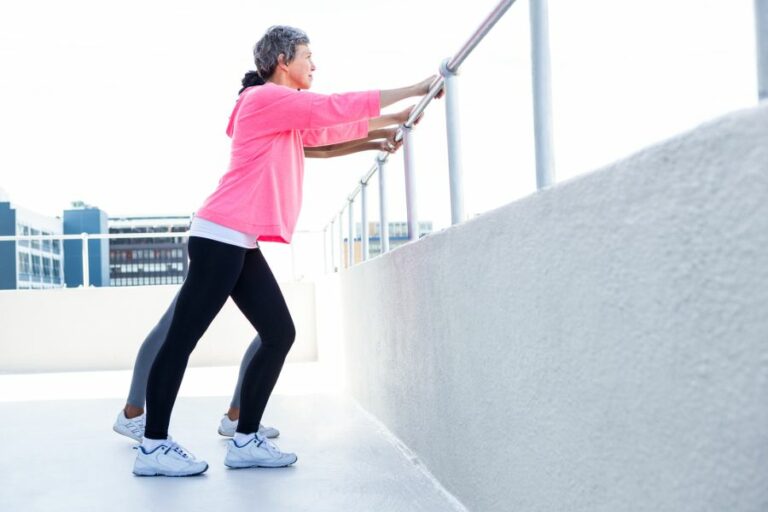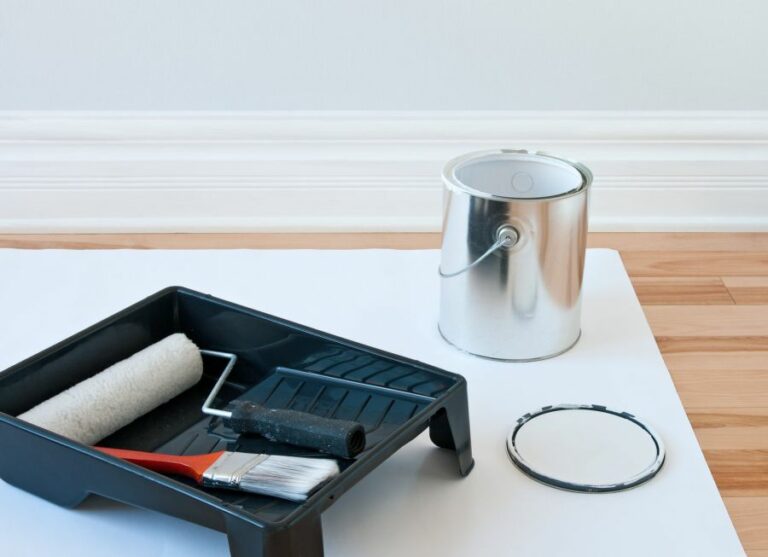Non-Slip Paint For Outdoor Wood Stairs. What Pros Say
As a homeowner, safety should always be your top priority, especially for outdoor wood stairs. You want to be sure that your family and guests can navigate these areas without worrying about slips and falls. Thankfully, we’ve got you covered with the perfect solution. Through our extensive research and experience, we have discovered the ideal non-slip paint for outdoor wood stairs that will eliminate the risk of slip-related injuries while maintaining the beauty of your outdoor space.
Non-slip paint for outdoor wood stairs:
Non-slip paint for outdoor wooden staircases is crucial for safety, as it prevents slips and falls caused by rain, snow, or ice. This paint contains a rough, textured surface that aids in traction. The main types of non-slip paint are acrylic latex paint, epoxy paint, and pre-mixed non-slip paint. Proper application and maintenance ensure the paint’s effectiveness and durability, reducing potential accidents.

Tired of slipping on your wooden stairs every time it rains or snows? Fear not! In the paragraphs below, we’ll dive into the world of non-slip paint solutions specifically designed for outdoor wooden stairs.
Discover the best products, application techniques, and expert tips to make your stairs safe and stylish. Read on to reclaim your steps and say goodbye to hazardous falls.
Contents
- 1 Anti-Slip Paint for Outdoor Wooden Staircases
- 2 What are the effective solutions to apply on outdoor wooden stairs to minimize the risk of slipping?
- 3 What is the Most Effective Non-Slip Finish for Wooden Staircases?
- 4 Is There an Anti-Slip Paint Solution for Staircases?
- 5 Which Type of Paint Should Be Used on Exterior Staircases?
Anti-Slip Paint for Outdoor Wooden Staircases
• The Importance of Non-Slip Paint
Outdoor wood stairs are exposed to various elements, such as rain, snow, and ice, making them slippery and dangerous to use. Slips and falls can lead to serious injuries, which is why it’s important to take preventive measures to ensure the safety of anyone using wood stairs.
One of the most effective ways to do this is by applying non-slip paint.
Non-slip paint is specially designed to provide a rough, textured surface that prevents slipping. It’s important to choose the right type of non-slip paint for your specific needs and follow proper application techniques to get the desired results.
• Choosing the Best Non-Slip Paint for Your Stairs
There are different types of non-slip paints available on the market, which vary in terms of durability, adhesion, and texture. Here are the main types of non-slip paint you can choose from:
– Acrylic Latex Paint
Acrylic latex paint is a popular choice for outdoor wood stairs because of its ability to bond well to wood surfaces and provide excellent weather resistance. You can enhance the non-slip properties of acrylic latex paint by adding a fine aggregate, such as sand, or specially designed non-slip additives.
– Epoxy Paint
Epoxy paint is another suitable option for outdoor wood stairs, offering better durability and adhesion compared to acrylic latex paint. This type of paint also resists chipping, peeling, and fading, making it a long-lasting solution.
Keep in mind that epoxy paint is a bit more difficult to work with, as it comes in two components (resin and hardener) that need to be mixed before application.
– Pre-mixed Non-Slip Paint
Pre-mixed non-slip paints are ready-to-use products that already contain both the paint and the non-slip additive. This is a convenient option for those who don’t want to deal with the hassle of mixing ingredients themselves.
However, they may not offer the same level of customization and might be more expensive than purchasing paint and the aggregate separately.
• How to Properly Apply Non-Slip Paint
For optimal results, it’s important to follow the right application steps when using non-slip paint for outdoor wood stairs. Here’s a step-by-step guide to help you achieve a safe, slip-resistant surface:
1. Prepare the Surface
Before applying any paint, the wood stairs must be properly cleaned and prepared. Remove any loose or peeling paint using a paint scraper, brush, or sandpaper. Clean the surface thoroughly to remove any dust, dirt, or debris, as these can affect the adhesion of the paint.
2. Apply a Primer
A primer is essential to help the paint adhere better to the wood surface and ensure its durability. Choose a primer specifically designed for outdoor wood surfaces, and follow the manufacturer’s instructions for application.
3. Mix the Non-Slip Additive
If you’re using acrylic latex or epoxy paint, mix the non-slip additive with the paint as per the manufacturer’s guidelines. For pre-mixed non-slip paint, this step is not necessary.
4. Apply the Paint
Use a paintbrush or roller to apply the first coat of non-slip paint, ensuring an even and consistent coverage. Start from the top of the stairs and work your way down. Allow the paint to dry as per the manufacturer’s recommended drying time.
5. Apply a Second Coat
For better protection and durability, apply a second coat of non-slip paint. Ensure that the first coat is completely dry before applying the second coat. Once again, let it dry for the recommended time.
• Tips for Maintaining Non-Slip Paint
To keep the non-slip paint on your outdoor wood stairs in top condition, follow these maintenance tips:
- Regularly clean the stairs to remove dirt, grime, and debris that can affect the paint’s effectiveness.
- Inspect the stairs periodically for signs of wear, fading, or damage to the paint. Address any issues to prevent further damage and maintain safety.
- Depending on the level of traffic and exposure to the elements, consider reapplying the non-slip paint every few years to maintain its effectiveness.
• Conclusion
Safety should always be a priority when it comes to outdoor wood stairs, and non-slip paint is an effective and relatively affordable solution to prevent slips and falls.
By choosing the right type of paint, following the proper application techniques, and maintaining the surface, your outdoor wood stairs can remain a safe and durable feature of your home or property.
What are the effective solutions to apply on outdoor wooden stairs to minimize the risk of slipping?
• Introduction
Outdoor wooden stairs are an elegant and attractive addition to any property. However, they can be a safety hazard when they get slippery due to precipitation or other environmental factors.
• Importance of Proper Maintenance
Before we delve into specific solutions, it is essential to emphasize the importance of proper maintenance for your wooden stairs. Cleaning the stairs regularly and promptly removing debris, such as leaves, twigs, and dirt, will minimize the chances of slips and falls.
Further, applying wood treatments and sealants will not only protect the wood from environmental factors but can also offer added traction. Make sure to follow the manufacturer’s instructions when applying these products.
• Non-Slip Tread Options
– Rubber Treads
One of the simplest and most effective ways to prevent slipping on wooden stairs is by installing non-slip rubber treads. These durable and weather-resistant treads provide excellent traction and are easy to install, making them a popular option among homeowners. T
hey are available in various designs and colors, allowing you to choose one that complements your stairs’ appearance. Safety Research Association recommends rubber treads as an affordable and reliable solution for slip prevention.
– Non-Slip Tape
Non-slip tapes, also known as anti-slip tapes, provide an easy and affordable way to add traction to outdoor wooden stairs. They come in various colors, including clear, allowing you to maintain your stairs’ natural beauty while adding safety features.
Make sure to choose a non-slip tape specifically designed for outdoor use and follow the manufacturer’s installation instructions for the best results.
– Carpet Treads
Carpet treads are another option to consider for adding slip resistance to your outdoor wooden stairs. They offer better traction, especially in wet conditions, while adding a touch of style to your staircase.
However, make sure to choose carpet treads made from weather-resistant materials, such as polypropylene or olefin, to ensure durability and longevity.
• Paints and Coatings
– Anti-Slip Paint
When it comes to slip prevention on wooden stairs, anti-slip paint is an excellent choice. Most anti-slip paints contain grit-like particles that provide added traction upon application. They are available in various colors and finishes, allowing flexibility in appearance.
Before applying the paint, clean the surface of the stairs thoroughly and make sure it is dry. For optimal results, consider applying a primer and following the product’s instructions regarding drying time and the number of coats needed.
– Textured Coatings
Textured coatings, such as sand-based and epoxy resin-based coatings, offer an effective solution for increasing outdoor wooden stairs’ slip resistance. These coatings create a textured surface upon application, providing added traction.
While these products tend to be more expensive than anti-slip paints, their durability and effectiveness make them worth the investment.
When purchasing a textured coating, pay attention to the product’s specifications in terms of application temperature and humidity conditions, as well as drying time and recommended number of coats.
• Additional Safety Measures
– Handrails
Installing handrails on outdoor wooden stairs is an essential safety feature that can provide additional support and stability, especially when the stairs are slippery. Ensure that the handrails are sturdy and mounted at an appropriate height to maximize their effectiveness.
– Adequate Lighting
Proper lighting is crucial for ensuring the safety of outdoor stairs. Adding lights, such as solar-powered or motion-activated lights, can help illuminate the stairs, making it easier to see potential hazards and prevent accidents.
– Regular Inspections
Regularly inspecting your outdoor wooden stairs for damage, rot, or weakened areas can help prevent accidents caused by structural issues. Repair or replace any damaged parts promptly and keep an eye on the durability of the anti-slip solutions you’ve applied, as their effectiveness may diminish over time.
• Conclusion
Ensuring the safety of your outdoor wooden stairs is a critical aspect of responsible property ownership. With the solutions and recommendations presented in this article, you can take the necessary steps to prevent accidents and make your outdoor staircase a safer place for everyone.
Remember that regular maintenance and periodic inspections are essential for maximizing these solutions’ effectiveness and ensuring your stairs remain slip-resistant in the long run.
Option | Description |
|---|---|
Anti-Slip Tape | Provides extra traction on wooden stairs, making them safer to walk on. Available in various colors and styles for different stair designs. |
Rubber Treads | Prevents slipping by adding a textured rubber surface to the steps. Easy to install and maintain, and can be removed when not needed. |
Non-Slip Paint | A paint that has a textured, gritty surface when dry. It is applied to the stairs to create a non-slip surface for better grip and safety. |
Carpet Treads | Carpet pieces that can be attached to staircase steps, providing both traction and cushioning. Available in many colors and designs to match your home decor. |
Wood Stair Treads | Stair treads made from a combination of wood and other materials, such as rubber, plastic, or metal, that provide a non-slip surface on the steps. |
What is the Most Effective Non-Slip Finish for Wooden Staircases?
Slippery wooden stairs can be a safety hazard in any home or building. A non-slip finish is essential for preventing accidents, especially in homes with young children, elderly people, or individuals with mobility issues.
• Sand in the Finish
One tried-and-true method to add traction to wooden stairs is by mixing sand with a clear finish, like polyurethane or varnish. Sand is an inexpensive and widely available material, making this solution cost-effective for many people.
– Pros
- Cost-effective
- Wide range of grit sizes available depending on desired texture
- Can be easily applied with a brush or roller
– Cons
- May not be the most aesthetically pleasing option
- Regular reapplication may be necessary, depending on traffic and wear
To achieve the best results, fine grit sand should be used, and the sand-to-finish ratio should be tested on a scrap piece of wood before applying it to the stairs. More information on specific sand and finish mixtures can be found on woodworking forums or government safety websites.
• Anti-Slip Stair Treads
Another option is to apply anti-slip stair treads made of rubber, vinyl, or metal to provide extra traction on the surface of the stairs. These treads are available in a variety of colors, textures, and designs, so there’s likely an option to suit any taste or design preference.
– Pros
- Many design options available
- Can be applied to both indoor and outdoor wooden stairs
- Easy installation with adhesive or screws
– Cons
- May not adhere well to some wood finishes or paints
- Potential for damage to wooden stair surface during installation or removal
When selecting anti-slip stair treads, be sure the material is compatible with your existing wood finish or paint, and check for any potential warranty issues that may arise from using the treads with certain wood brands.
• Non-Slip Paints and Coatings
Non-slip paints and coatings are a convenient way to achieve a non-slip finish on wooden stairs. These products come in various formulas and can be found at most home improvement stores.
– Pros
- Designed specifically for non-slip purposes
- Available in a variety of colors and finishes
– Cons
- Can be more expensive than other methods
- May require professional installation
In addition to commercial non-slip paints, you can create a DIY version by mixing an abrasive material, like sand or commercial traction additives, into any standard paint or stain. However, be aware that mixing your finish could result in inconsistencies or uneven coverage.
For the best application and performance, follow the manufacturer’s instructions and consult consumer product safety organizations for additional advice.
• Traction Tape
Traction tape is an adhesive strip featuring a gritty, textured surface designed to increase traction on slippery surfaces. This tape is available in various widths, colors, and textures and can be quickly applied to any wooden stair.
– Pros
- Easy installation with minimal surface preparation
- Can be applied in patterns or designs for added visual interest
- Suitable for indoor and outdoor use
– Cons
- Adhesive backing may not adhere well to certain wood finishes
- May not last as long as other options and require replacement
Before applying traction tape, ensure the wooden stair surface is cleaned and free of any dust or debris. Check the tape’s compatibility with your existing wood finish or stain, and consider using several layers for increased durability.
• Conclusion: Determining the Best Non-Slip Finish
Choosing the best non-slip finish for your wooden stairs depends on several factors, including personal preferences for appearance, ease of application, and budget. Maintenance and durability should also be considered.
Sand in the finish is a cost-effective solution that may require more frequent touch-ups. Anti-slip stair treads offer an attractive design element but can potentially damage the wood surface.
Non-slip paints and coatings are specifically designed for slip prevention but can be more expensive than other options. Finally, traction tape is a simple and easy-to-apply method but may not last as long as other solutions.
Ultimately, it’s essential to select a non-slip finish that meets your needs and preferences while prioritizing the safety of those using the stairs. Always follow manufacturer guidance, and consider consulting with professional resources like safety organizations for the best results.
Non-Slip Finish | Description | Benefits |
|---|---|---|
Anti-Slip Stair Treads | Stair treads made of rubber or other materials that provide excellent traction on wooden stairs. | Easy to apply, durable, and provides a reliable grip for users. |
Anti-Slip Stair Nosing | Strips applied to the edge of each stair to prevent slipping. | Quick to install, suitable for most stair designs, and improves stair safety. |
Non-Slip Stair Paint | Specialized paint made with non-slip additives for creating a non-slip surface on wooden stairs. | Transforms stairs’ look while providing safety, easy to clean, and available in various colors. |
Anti-Slip Stair Tape | Self-adhesive strips applied to wooden stairs to create a non-slip surface. | Economical, available in different colors and sizes, and offers quick installation. |
Is There an Anti-Slip Paint Solution for Staircases?
Ensuring the safety of people while using stairs remains a significant concern for many individuals, especially in areas where moisture or heavy footfall is likely to cause slipping.
One effective solution to provide a better grip and reduce the risk of accidents on staircases is the use of non-slip paint specifically designed for this purpose.
• Benefits of Non-Slip Paint for Stairs
There are numerous advantages to using non-slip paint for your stairs. Some of these include:
– Enhanced Safety
The primary purpose of non-slip paint is to provide a safer walking surface on stairs. This reduces the risk of accidents caused by slipping, especially during wet or damp conditions.
– Durability
Non-slip paint creates a protective barrier on stair surfaces, making them more resistant to wear and tear. This ultimately helps prolong the lifespan of the stairs and reduces the need for frequent maintenance or replacement.
– Aesthetics
Non-slip stair paint is available in a variety of colors and finishes, allowing you to match the paint with the existing decor of your space. Besides enhancing the overall aesthetic, this also helps maintain a uniform appearance throughout your property.
– Easy Maintenance
Stairs painted with non-slip paint can be easily maintained by regular cleaning or occasional re-painting. This ensures that the stairs continue to provide adequate grip and remain visually appealing over time.
• Types of Non-Slip Paint for Stairs
There are several types of non-slip paint available for stairs, each with unique features and applications. Some of the most commonly used non-slip paints for stairs are:
– Epoxy Resin Paint
Epoxy resin paint is a versatile option that provides an added layer of protection to the stairs while also offering excellent slip resistance. This type of paint is particularly suitable for high-traffic areas or industrial use, where durability and stability are of utmost importance.
An example of this type of paint is the Watco Safety Grip, a well-established product in the market.
– Acrylic Latex Paint
Acrylic latex paint is a popular choice for non-slip stair paint due to its superior adhesion, quick drying time, and resistance to moisture. This type of paint can be used on a variety of surfaces like wood, concrete, or metal stairs.
One such product is Valspar Skid-Not Skid Resistant Coating, which offers a low-sheen, non-slip finish.
– Pre-Mixed Non-Slip Paint
Pre-mixed non-slip paints come with the added convenience of easy application, as they already contain the necessary non-slip additives. This eliminates the need for measuring and mixing different components before use.
A popular example of a pre-mixed non-slip paint is SlipDoctors Dura Grip, which offers excellent durability and slip resistance.
• Application of Non-Slip Paint for Stairs
Applying non-slip paint to stairs involves the following steps:
- Preparation: Clean the stair surface thoroughly to remove any dirt, dust, or debris. If necessary, sand the surface to achieve a smooth finish. Ensure the stairs are completely dry before applying paint.
- Priming: Apply a suitable primer on the stair surfaces to improve the adhesion of the paint. Priming also helps prevent the paint from peeling or chipping over time.
- Painting: Stir the non-slip paint well and apply a thin, even coat using a brush or roller. Allow the first coat to dry according to the manufacturer’s recommendations before applying a second coat. In some cases, you may need to apply multiple coats to achieve the desired level of slip resistance.
- Drying and Curing:
Allow the paint to dry completely before allowing foot traffic on the stairs. The time required for drying and curing will vary depending on the type of paint used and the environmental conditions.
In conclusion, using non-slip paint for stairs adds an extra layer of safety for users and helps prevent accidents caused by slipping.
With various types of non-slip paint to choose from and a simple application process, this solution is an excellent investment for enhancing safety and durability in both residential and commercial spaces.
My personal recommendation would be to consider epoxy resin paint for heavy-duty applications and acrylic latex paint for residential or light-duty staircases. Regardless of your choice, be sure to follow the manufacturer’s guidelines for proper application and maintenance.
Which Type of Paint Should Be Used on Exterior Staircases?
Exterior stairs are exposed to various weather conditions and heavy foot traffic, making it essential to choose the right paint for durability and longevity.
• Types of Paint for Exterior Stairs
1. Exterior Latex Paint
Exterior latex paint is a popular choice for painting outdoor surfaces, such as stairs, due to its durability, resistance to mildew and algae, and UV protection. This type of paint is water-based, making it easy to clean up and environmentally friendly.
Advantages
- Easy to apply and clean-up
- Dries quickly
- UV protection
- Low odor
- Resistant to mildew and algae growth
Disadvantages
- Not as durable as oil-based paint
- May not adhere well to some surfaces without proper preparation
2. Oil-Based Paint
Oil-based paint is known for its durability and long-lasting finish. It provides a harder, more durable surface compared to latex paint, making it suitable for high-traffic areas like exterior stairs.
Advantages
- Excellent durability
- Ideal for high-traffic areas
- Provides a hard, durable finish
- Can be applied over a wider range of temperatures
Disadvantages
- Longer drying time
- Strong odor
- Difficult to clean up
- Less environmentally friendly
3. Floor & Deck Paint
Floor and deck paint is specifically designed for surfaces that endure heavy foot traffic and weather exposure. This type of paint is available in both latex and oil-based formulas and is typically fortified with additional additives to prevent chipping, cracking, and peeling.
Advantages
- Designed for heavy foot traffic
- Weather-resistant
- Available in a variety of colors
- Slip-resistant additives can be included
Disadvantages
- More expensive compared to general exterior paints
- Limited color options compared to other paint types
• Tips for Applying and Maintaining Exterior Stair Paint
– Preparing the Surface
Proper surface preparation is essential to ensure the paint adheres well and lasts longer. Make sure to clean the stairs thoroughly, removing any dirt, debris, and loose paint. Repair any damages, such as cracks and chips, and sand the surface to achieve a smooth and even base.
If the stairs are made of untreated wood or are very porous, apply a suitable primer to improve paint adhesion.
– Application Techniques
When painting exterior stairs, use a brush to cut in around the edges and a roller or sprayer to apply the paint evenly across the surface.
Be sure to follow the manufacturer’s instructions regarding proper application technique and drying times. If needed, apply a second coat for better coverage and protection.
– Slip-Resistant Additives
To prevent slips and falls, consider adding slip-resistant additives to your chosen paint. These additives, usually in the form of fine aggregates, will provide texture to the paint, increasing its grip and reducing the risk of accidents.
– Regular Maintenance
Regular maintenance is essential to prolong the life of your exterior stair paint. Keep the stairs clean and free of debris, as dirt and moisture can weaken the paint over time.
Inspect the stairs periodically for signs of wear and tear or damage, and touch up the paint as needed to maintain its appearance and protective properties.
• Which Paint to Choose?
When deciding on which paint to use for your exterior stairs, consider factors such as the stair material, weather conditions, foot traffic, desired finish, and ease of application.
In general, exterior latex or floor and deck paint should suffice for most situations, as they offer good durability, weather resistance, and ease of application. However, if you require a higher level of durability and longevity, oil-based paint might be the better choice.
Ultimately, it is essential to pick a paint that meets your specific requirements and preferences. By following the tips outlined in this article, you will be well-equipped to select the right paint for your exterior stairs and ensure its long-lasting performance.







